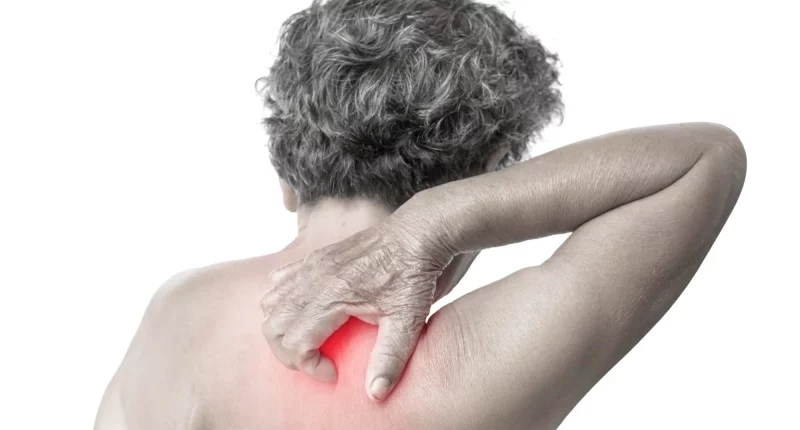Shoulder bursitis is when the bursae in the shoulder joint become painful and inflamed. Bursae are small sacs filled with fluid that cushion joints and prevent friction between muscles, bones, and tendons.
When a shoulder bursa gets irritated, it swells up. This swelling reduces the space in the shoulder joint, making it painful to move and limiting shoulder mobility.
Shoulder bursitis can happen from overusing the shoulder, getting injured, or having long-term conditions like rheumatoid arthritis. Resting the shoulder and doing gentle exercises can help it heal faster.
Symptoms
Shoulder bursitis presents several key symptoms. This includes pain usually felt around the tip or outside of the shoulder, which gets worse when touched. Patients may also notice a reduced range of movement in the shoulder joint and observe redness and swelling over the shoulder part. Activities such as raising the arm, like reaching for shelves or head bath, often exacerbate shoulder pain.
Pain associated with shoulder bursitis may intensify at night, particularly when sleeping on the affected shoulder, which can increase shoulder bursitis.
The most common type of shoulder bursitis occurs in the subacromial bursa, a large sac located at the shoulder’s tip. This bursa plays a crucial role in facilitating gentle movement when the hand is raised above the head.
If these symptoms are accompanied by a fever, it could indicate an infection of the bursa, known as septic bursitis. In such cases, it is important to seek medical attention promptly for proper evaluation and treatment.
Treatment
Treating shoulder bursitis can be effectively managed both at home and with medical intervention.
At home, over-the-counter anti-inflammatory medications like ibuprofen or aspirin can help reduce discomfort and inflammation in the shoulder. Resting the shoulder and minimizing movements that might aggravate the bursa can aid in healing. Using a shoulder brace can provide additional support, and gentle exercises can prevent stiffness in the joint.
Applying ice packs to the affected area within the first 5 days of injury or overuse can also help decrease swelling and pain. It’s advised to apply ice every 15 to 20 minutes, several times a day.
For persistent symptoms, medical intervention may be necessary. A healthcare provider can administer corticosteroid injections directly into or over the bursa to reduce inflammation and pain. Although the effects may be non-permanent, this treatment can be repeated if needed.
In cases where shoulder bursitis persists despite other treatments over 6 to 12 months, the operation may be considered as a last resort. The surgical intervention aims to repair any damage and alleviate stress within the bursa, helping to improve long-term shoulder function and comfort.
Causes and Risk Factors
Shoulder bursitis is often caused by continuous movements or overutilization of the shoulder joint. This can happen from doing the same motion over and over again, like in sports or certain hobbies. Physical injuries, like those from a car accident or a fall, may also lead to bursitis.
Leisure activities that put a lot of stress on the shoulder can cause bursitis. This includes activities like tennis, baseball, weight training, and knitting. Individuals who have jobs that require a lot of shoulder movement, such as painters, athletes, and musicians, are also more likely to develop shoulder bursitis.
Certain medical conditions can increase the risk of shoulder bursitis. These involve rheumatoid arthritis, which causes joint inflammation; diabetes, which affects the body’s ability to heal; and gout, which causes joint pain and swelling.
Recovery Time
The recovery time for shoulder bursitis depends on what caused it. If it’s from a physical injury, treatment can help it get better in just a few days.
When bursitis happens because of overusing the shoulder, like in sports or work, it might take several weeks or longer to heal. This is especially true if the shoulder keeps being used during recovery.
If there are other issues with the shoulder, like tendon problems or bone issues, healing from bursitis might take even longer.
Sometimes, shoulder bursitis can become chronic, especially when it’s caused by medical conditions like rheumatoid arthritis. This means it can last a long time and might need ongoing care to manage symptoms.
Diagnosis
To diagnose shoulder bursitis, a healthcare provider will begin by asking about your profession, medical history, and leisure activities to understand possible risk factors.
The diagnostic process may involve several tests:
- Physical Exams: During a physical exam, the healthcare will assess the area of your pain, test muscle strength, and check the range of movement in your shoulder joint. These observations can often help in diagnosing bursitis.
- Radiography (X-rays): While X-rays do not directly show the bursa, they are useful for eliminating arthritis or bone damage that could lead to shoulder pain. This helps healthcare providers decide on the most appropriate medication.
- MRI Scans: MRI scans may be used to detect inflammation or any impact on the bone and nearby tissues. Although not always necessary for diagnosis, MRI scans provide detailed information when needed.
- Fluid Testing (Aspiration): In some cases, fluid may be extracted from the bursa for testing to eliminate infection. This procedure, known as aspiration, helps confirm or exclude infections as a cause of shoulder symptoms.
These diagnostic tools and procedures help doctors accurately diagnose shoulder bursitis and determine the best course of treatment based on the underlying cause and severity of the condition.
Prevention
Preventing shoulder bursitis involves minimizing strain on the shoulder joint through various strategies. Here are some effective prevention tips:
- Stretching and Warm-up: Before engaging in exercise or activities that involve repetitive shoulder movements, it’s important to warm up properly and stretch the shoulder muscles. This helps prepare the muscles and joints for activity, reducing the risk of strain.
- Shoulder Muscle Strengthening: Gentle exercises that strengthen the shoulder muscles can improve joint stability and resilience. This can be achieved through targeted exercises recommended by a healthcare professional or physical therapist.
- Gradual Progression: When beginning a new activity that stresses the shoulder, it’s crucial to progress slowly. Gradually increasing intensity and duration allows the shoulder to adapt without causing undue strain or injury.
- Take Regular Breaks: Regular breaks can prevent overuse if you’re using your shoulder repeatedly, such as during work or sports. This gives the shoulder time to rest and recover, reducing the likelihood of developing bursitis.
- Posture Improvement: Maintaining good posture helps engage the shoulder muscles and reduces pressure on the joints. Proper posture distributes workload evenly across the muscles, preventing excessive strain on any particular shoulder area.
By incorporating these preventive measures into your daily routine, you can significantly reduce the risk of developing shoulder bursitis and maintain shoulder health and mobility over time.
Outlook
Most people recover fully from shoulder bursitis with proper treatment. Symptoms often improve within several weeks.
Treatment typically involves rest and using anti-inflammatory medications, which are very effective for relieving pain and reducing swelling in the shoulder. However, if there are additional shoulder issues like bone issues or tendinitis, ongoing physical therapy may be necessary to support long-term recovery.
To prevent future episodes of bursitis and improve overall outlook, it’s important to find the right balance in activities. This means avoiding activities that can strain the shoulder joint too much and cause bursitis to flare up again. Recognizing lifestyle triggers that contribute to shoulder strain is essential in managing and preventing shoulder bursitis effectively. By making these adjustments, individuals can maintain shoulder health and reduce the likelihood of recurring bursitis.
Summary
Shoulder bursitis is an inflammation of the bursae, causing pain and reduced movement. It’s often due to repetitive movements, injuries, or medical conditions like arthritis. Diagnosis involves physical exams, X-rays, MRI scans, and fluid testing.
Treatment includes rest, anti-inflammatory medications, ice packs, and sometimes steroid injections or surgery. Prevention focuses on reducing shoulder strain through warm-ups, muscle strengthening, gradual activity increase, breaks, and good posture. Recovery is likely within a few weeks, but managing activity levels is key to preventing recurrence.








